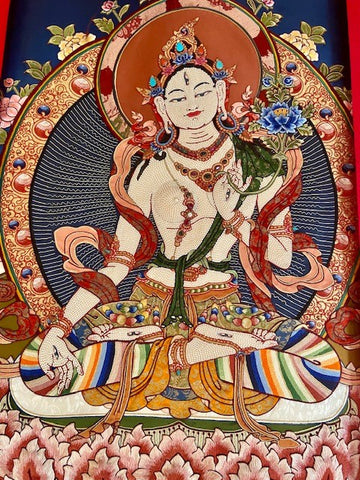
Appreciating Thangka Paintings
Share
"There are no bad thangka paintings, just bad mistakes".
How to Judge and Tell the Quality of Thankga Paintings
Thangkas are sacred paintings on cotton canvas from the Himalayan region depicting Buddhist deities, scenes and motifs. They are typically mounted on a brocade silk backing and can be commonly seen in Tibetan homes and monasteries.
During our recent trip to Nepal, we had the opportunity to speak to a number of people involved in the thangka trade. We spoke to gallery owners, artists, customers and elders to try and understand what made thangka paintings special, and what made some so expensive even though they were of the same size and featured the same subject.
Here are some learnings from our conversations with them.
1. Importance/Prior Use: Thangkas are sacred art and the most prized ones are those that have belonged to an important lama or monastery. Many are also heirloom pieces passed down from generation to generation during important events such as weddings. In most cases, these thangka paintings will never be available for purchase, and so it is a matter of one's karma to be able to own such a piece or come across one that is available for purchase.
2. Detail / Craftsmanship: High quality thangkas feature a lot of fine detail and craftsmanship e.g. are the smaller elements in the painting visible? (Many thangkas as an example will feature a secondary or third deity. For wrathful deities, hell beings are often depicted.) Are these elements of the thangkas clear and visible? How fine are the artist's brushstrokes? For mandala paintings, are the smaller Dharma Chakras/Wheels and similar motifs shown well drawn?

3. Accuracy: Drawing a thangka painting requires a certain level of understanding of Buddhism. Are the deities shown in the thangka accurately described in form and gesture? e.g. Green Tara has her right leg outstretched. So a painting with her left leg outstretched isn't technically accurate regardless of how well it's drawn. How do the faces of the deities appear and are they in proportion?
4. Colour Palette and Material: Mineral pigments were traditionally used in Tibetan thangka paintings. The same was also used in frescoes found in old monasteries with colours perfectly preserved and vibrant. A skilled thangka painter will mix colours so that they are well balanced and consistent across the painting. Many thangkas also have 24 carat gold pigment used to highlight any jewels that may adorn a deity. Others might feature gemstones or silk applique, which adds to the cost of material.

5. Time and Effort: It is not uncommon for thangka painters to spend a considerable amount of time on their art. e.g. a Masterpiece thangka featuring 21 Taras that we recently saw took nearly five years for the artist to complete.

(Image above: Mineral pigments used in traditional thangkas. Mixing them takes time and effort).
6. Artist Reputation: This one is very difficult to consider given that thangka painters traditionally don't sign their work as a mark of humility. Does the artist understand Buddhist philosophy and meaning or are they simply making a painting from a picture they found online? Are they of good character and honest, and does their inner peace/energy carry across to their thangkas? Master Thonla thinks this is specially important.
Master thangka painters usually have over 25 years of experience whereas students/apprentices have 1-3 years.
At Tibet Shop Sydney, we have recently sourced high quality mandala paintings drawn by both master and apprentice artists to give our customers choice. We hope that you find this article useful when selecting your next thangka/mandala painting.
